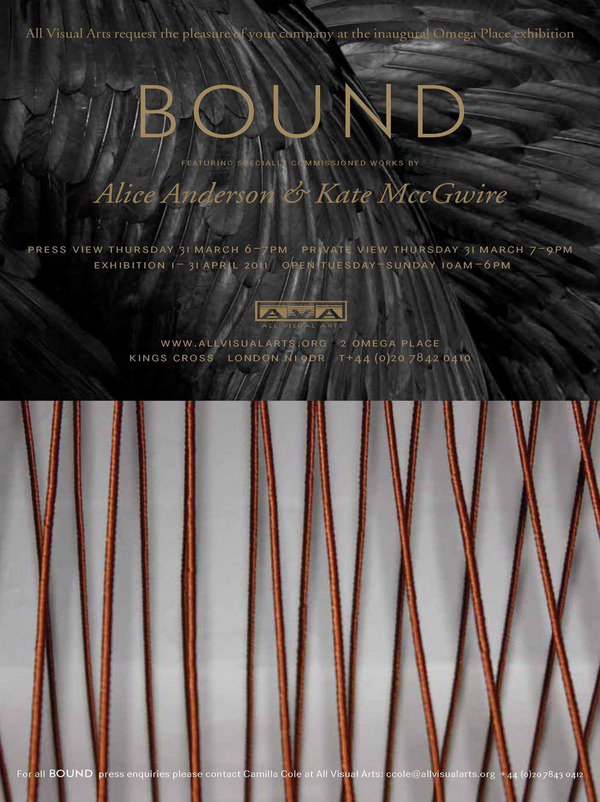Alice Anderson and Kate MccGwire
dal 30/3/2011 al 29/4/2011
Segnalato da
30/3/2011
Alice Anderson and Kate MccGwire
All Visual Arts (AVA), London
BOUND is the inaugural exhibition at All Visual Arts a new space at Kings Cross. Featuring new work by Anderson and MccGwire that tap into some of our deep-seated fears. The space is dominated by two sculptures, one by each artist, specially commissioned by AVA. Anderson's Fort-Da is evocative and autobiographical. MccGwire's Corvid is the contrary, instinctual and without narrative.

BOUND is the inaugural exhibition at All Visual Arts’ (AVA) new space at Kings Cross. Featuring new work byAlice Anderson and Kate MccGwire that tap into some of our deep-seated fears. The space is dominated by two sculptures, one by each artist, specially commissioned by AVA. Anderson’s Fort-Da is evocative and autobiographical. MccGwire’s Corvid is the contrary, instinctual and without narrative.
MccGwire’s Corvid is a writhing, serpentine formation made of crows’ feathers, a bird associated in folklore with thieving and deviant behaviour. By using archetypal shapes and materials that embody human qualities MccGwire is able to manifest different states of mind in physical form.
MccGwire works with pigeon, mallard and magpie as well as crows’ feathers, each of which prompt different cultural associations. The pigeon is regarded as 'a rat with wings', the magpie a thief, the crow a deviant bearer of bad news. (The crows' feathers used in Corvid were sent to her by gamekeepers and farmers who shoot the birds to stop them damaging crops and fledgling birds.)
Anderson’s sculpture has its origins in a body of work that will be featured in her solo exhibition at London's Freud Museum Alice Anderson’s Childhood Rituals (15 April - 5 June 2011). Fort-Da is a three metre high bobbin with ropes of red dolls hair wound around it. For Anderson dolls’ hair refers to her rituals enacted in childhood and symbolizes the link between a mother and her child. The bobbin becomes an emblem of the mother's absence.
Anderson's Fort-Da refers to a game invented by Sigmund Freud's one-year-old grandson. The infant would throw a wooden reel attached to a piece of string over his cot and then retrieve it, a gesture he would repeat again and again. Freud understood the child to be saying 'Fort' and 'Da' (meaning 'gone' and 'there' in German), theorizing that the game allowed the boy to adapt to the anxiety caused by his mother's absence. The game parallels one Anderson resorted to in her own childhood. In her version the wound hair tightly bonded to the bobbin becomes symbolic of her attachment to her mother, and the compulsive act of winding the hair, a way of facing the angst caused by her mother’s absence.
Anderson’s ambiguous relationship to the maternal - both protective and oppressive - incites a sensation of anxiety that is echoed by the ambivalent nature of MccGwire’s Corvid; on the one-hand appearing to be an inanimate mass of feathered rope, on the other threatening at any moment to spring to life
Corvid’s form is muscular and tensile, as if it has the power to restrain. Without beginning or end, it is like the pattern of our thoughts, endlessly repeating and turning in on itself, never coming to any kind of conclusion. This endless repetition also appears in Anderson’s Fort Da,in the implied action of the compulsive winding of dolls’ hair around the bobbin as a substitute to ease the anxiety of separation.
Kate MccGwire (b 1964) graduated in 2004 from The Royal College of Art. Her work has been exhibited at the Saatchi Gallery ('Brood'), the Museum of Arts and Design, New York, the 2010 Tatton Park Biennial and Tunnel 228. She was a winner of the 'Heart of Glass' Award 2008 (run in association with the Contemporary Art Society) and has taken part in residencies in China and the USA. She will have her first solo show at AVA in 2012 (date tbc).
Alice Anderson (b 1976) studied with Christian Boltanski at L'Ecole des Beaux-Arts, Paris, and graduated from Goldsmiths College, London, where she lives and makes her autobiographical work based on fictional childhood memories. In 2010 her work was exhibited at Tate Modern London, Centre Georges Pompidou, Paris, Nichido Contemporary Art, Tokyo, Riso Art Museum, Sicily, National Taiwan Museum, Taipei, Fondation Agnes b, Paris, Cinémathèque Française, Paris, Busan Biennale, South Korea, and Riflemaker, London.
For all BOUND press enquiries please contact Camilla Cole at All Visual Arts
ccole@allvisualarts.org + 44 (0)20 7843 0412
Opening 31 March 2011, 6-7pm
All Visual Arts
2 Omega Place, Kings Cross, London
Hors: tue-sun 10-6pm
admission free





